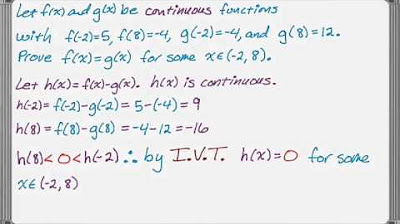Were you ever exactly 3 feet tall? The Intermediate Value Theorem
TLDRThe video script presents an engaging explanation of the Intermediate Value Theorem, a fundamental concept in calculus. The presenter uses the analogy of human growth to illustrate the theorem, noting that if a person is once shorter than three feet and later taller, there must be a point at which they are exactly three feet tall. This continuous growth is likened to a continuous function of time. The theorem is then formally introduced, stating that for a continuous function on a closed interval, if a value 'n' lies between the function's values at two points 'a' and 'b', there exists a point 'c' within the interval where the function equals 'n'. The presenter emphasizes the importance of the function's continuity and provides a visual representation to aid understanding, making the complex mathematical concept more accessible.
Takeaways
- 📈 The concept introduced is the Intermediate Value Theorem, which is a fundamental theorem in calculus.
- 👶 The theorem is illustrated using the example of a person's height as a function of time, which grows from less than three feet to over four feet.
- ➡️ It is assumed that height is a continuous function of time, meaning there are no abrupt jumps in height.
- 👶👵 The theorem states that if a function is continuous on a closed interval [a, b] and takes on values f(a) and f(b), then it must take on all values between f(a) and f(b) at some point within that interval.
- 📌 The example uses two specific points, A and B, to represent times when the person's height was less than and greater than three feet, respectively.
- 🔍 A value 'n' is chosen between f(a) and f(b), and the theorem predicts the existence of a point C where the function f(C) equals n.
- 🤔 The theorem is applicable when the function is continuous over the interval [a, b], which is a condition that needs to be investigated for its necessity.
- 📍 The theorem is symbolized with a '∈' symbol, indicating that 'n' is an element of the interval between f(a) and f(b).
- 🔢 The theorem guarantees the existence of at least one value 'c' within the interval [a, b] such that f(c) = n, without necessarily providing a method to find 'c'.
- 🔄 The Intermediate Value Theorem is a powerful tool in mathematical analysis and has implications for solving equations and understanding the behavior of functions.
- 🚀 The theorem is a cornerstone in demonstrating that continuous functions have certain properties, which are essential in various fields of mathematics and science.
Q & A
What is the main argument presented in the transcript?
-The main argument is about the concept of the Intermediate Value Theorem, which states that if a function is continuous on a closed interval and takes on values less than and greater than a certain number, it must also take on that number at some point within the interval.
What is the Intermediate Value Theorem?
-The Intermediate Value Theorem is a fundamental theorem in calculus that asserts that for a continuous function, if it takes on values less than and greater than a certain number within an interval, then it must also take on that number at some point within that interval.
Why is the continuity of a function important in the context of the Intermediate Value Theorem?
-Continuity is important because it ensures that there are no gaps or jumps in the function within the interval. This guarantees that the function will indeed take on all values between its minimum and maximum on that interval, allowing the theorem to hold.
What does it mean for a function to be 'continuous'?
-A function is 'continuous' at a point if the limit of the function as it approaches that point equals the function's value at that point. More generally, a function is continuous on an interval if it is continuous at every point within that interval, meaning there are no abrupt changes in the function's value.
What is the significance of the points A and B in the context of the theorem?
-Points A and B represent two specific points in the domain of the function where the function takes on values less than and greater than the value N, respectively. These points are used to define the interval within which the theorem asserts that the function must take on the value N.
How is the value N chosen in the context of the Intermediate Value Theorem?
-The value N is chosen to be any number between the function values at points A and B (F(A) and F(B)). The theorem then guarantees that there exists some point C within the interval [A, B] where the function F(C) is exactly equal to N.
What is the role of point C in the theorem?
-Point C is the point within the interval [A, B] where the function F(C) is exactly equal to the value N. It is the key element that demonstrates the theorem's claim that the function must take on the value N within the interval if it is continuous.
Can the Intermediate Value Theorem be applied to discontinuous functions?
-No, the Intermediate Value Theorem specifically requires the function to be continuous on the interval in question. If the function is discontinuous, the theorem does not apply, and there is no guarantee that the function will take on every value between its minimum and maximum on that interval.
What is the domain of the function in the context of the Intermediate Value Theorem?
-The domain of the function, in the context of the theorem, is the interval [A, B] where the function is continuous and where the values F(A) and F(B) are known. This interval is where the theorem seeks to find a point C such that F(C) equals the value N.
How does the Intermediate Value Theorem relate to real-world phenomena?
-The Intermediate Value Theorem has applications in various real-world phenomena where continuous change is observed, such as in physics, engineering, and biology. It can be used to predict the existence of solutions to problems involving continuous processes, like finding equilibrium points in a system or determining the existence of a critical value in an optimization problem.
What are some common misconceptions about the Intermediate Value Theorem?
-A common misconception is that the theorem guarantees the existence of a single point where the function equals N, when in fact it only guarantees the existence of at least one such point. Another misconception is that the theorem applies to all functions, but it specifically requires the function to be continuous.
Can the Intermediate Value Theorem be used to prove the existence of roots of a function?
-Yes, the Intermediate Value Theorem is often used to prove the existence of roots (or zeros) of a function. If a continuous function changes sign over an interval, i.e., it takes on positive and negative values, the theorem ensures that there is at least one root within that interval.
Outlines
📏 Intermediate Value Theorem Explained
This paragraph introduces the concept of the Intermediate Value Theorem (IVT) through the analogy of human growth in height. It explains that as we grow from infancy to adulthood, our height increases continuously, never jumping abruptly from one value to another. The speaker uses the idea that if at any point in time we were less than three feet tall and at another point more than three feet tall, and assuming our height is a continuous function of time, there must have been a moment when we were exactly three feet tall. This leads to the formal statement of the IVT, which asserts that if a function is continuous on a closed interval [a, b] and n is any value between f(a) and f(b), then there exists some c in the interval (a, b) such that f(c) = n.
Mindmap
Keywords
💡Continuous Function
💡Intermediate Value Theorem
💡Height Progression
💡Theorem
💡Domain
💡Function
💡Graph
💡Interval
💡Value
💡Baby
💡Adulthood
Highlights
The concept of the Intermediate Value Theorem is introduced, which states that if a function is continuous on a closed interval and takes on values less than and greater than a certain number, then it must also take on that number at some point within the interval.
The theorem is illustrated with a hypothetical example of a person's height as a continuous function of time, transitioning from being less than three feet tall to more than four feet tall.
The importance of continuity in the function is emphasized, as it is a prerequisite for the theorem to hold true.
The theorem is formalized with mathematical notation, defining the function f(x), the interval [a, b], and the value n within the range of f(a) and f(b).
The theorem is applied to a graphical representation, where a point C is identified on the curve such that f(C) equals the value n, exactly three feet tall in the example.
The theorem is applicable to any continuous function, not just the example of height over time.
The theorem guarantees the existence of a value C within the interval [a, b] that matches the value n, without providing a method to find it.
The theorem is a fundamental principle in calculus and has broad implications for the behavior of continuous functions.
The example of height as a function of time serves to make the theorem more relatable and easier to understand.
The transcript provides a clear explanation of the theorem's conditions, including the requirement for the function to be continuous on the interval [a, b].
The theorem is presented as a tool for proving the existence of solutions to certain types of problems in mathematics.
The concept of 'sandwiching' a value n between f(a) and f(b) is used to explain why a value C with f(C) = n must exist within the interval.
The theorem is applicable to real-valued functions of a single variable, which are continuous on a closed interval.
The transcript uses the example of a person's height to illustrate the theorem in a practical, everyday context.
The theorem is a cornerstone of real analysis and is used to establish the existence of roots of continuous functions.
The proof of the theorem is not provided in the transcript, but the conditions under which it holds are clearly stated.
The theorem is a simple yet powerful result that has wide-ranging applications in various fields of mathematics and science.
The transcript effectively communicates the essence of the theorem in a way that is accessible to those with a basic understanding of calculus.
Transcripts
Browse More Related Video

Calculus 1 Lecture 3.2: A BRIEF Discussion of Rolle's Theorem and Mean-Value Theorem.

Intermediate value theorem example | Existence theorems | AP Calculus AB | Khan Academy

AP Calculus Review Three Theorems You Must Know (EVT, IVT, MVT)

Mean value theorem | Existence theorems | AP Calculus AB | Khan Academy

Using the Intermediate Value Theorem Examples

Mean value theorem for integrals | AP Calculus AB | Khan Academy
5.0 / 5 (0 votes)
Thanks for rating: